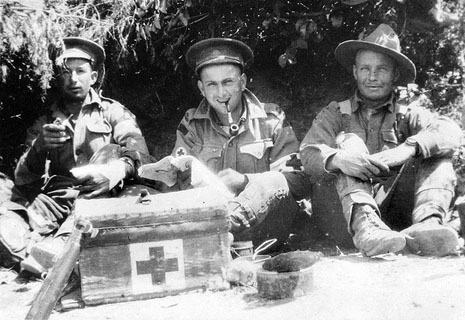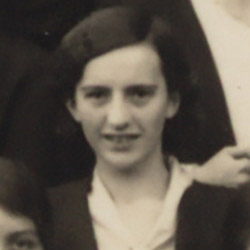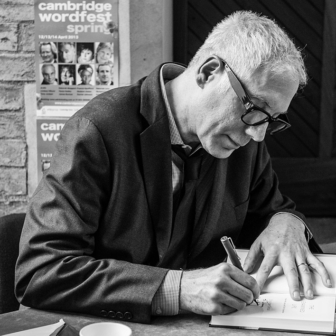Broken Nation: Australians in the Great War
By Joan Beaumont | Allen and Unwin | $55
MY GRANDFATHER, Frank Saunders, was a young man of privilege and promise. English-born, he won a scholarship to King’s College, Cambridge, in 1907. One of his fellow undergraduates was Rupert Brooke, though whether they knew each other intimately I have no idea, for my grandfather died from mustard gas complications when I was still a baby. He kept diaries of his war experiences, recording the landing at Gallipoli – his rifle was grazed by a Turkish bullet – the church service that preceded it, and the remainder of the day spent digging trenches. Unfortunately for the historian, his entries at Gallipoli – as well as those that cover the rest of his war at various locations in France – are brief, displaying no great literary merit. By his account, the worst day of his enlistment came when he had to shoot his beloved horse, Florence, before leaving the sodden fields of slaughter.
The horror continued through the decades. My father, Eric Saunders, who volunteered for the Second Australian Imperial Force in 1940, was severely injured just before the Battle of El Alamein, where he was serving as a forward scout. Following field surgery, he spent two years learning to walk again at a repatriation hospital in Brisbane. When I was a small child in the 1950s my family made what seemed like interminable trips to see him, first at Rosemount and then at the Greenslopes Repatriation Hospital. Whole wards were full of sick and injured men, some of them very young – no doubt having fought in Korea – others in their twenties and thirties like my father, and others, even more sadly, who had clearly been injured during the first world war. Because my father was frequently in hospital undergoing surgery, I became accustomed to the regulars and to those who would never leave. Several old men had been there since the war; no one ever visited them, and they seemed entirely alone and forgotten.
What makes Joan Beaumont’s account of Australia’s war so compelling is that she makes the lives of those forgotten men so real to us today. Broken Nation is a highly ambitious and consummate enterprise of a kind that few have attempted, let alone accomplished. Beaumont is professor of history at the Australian National University’s renowned Strategic and Defence Studies Centre, and the scope and breadth of this book attest to the skills of a historian at the height of her powers. Her previous books and articles, including the edited volume Australia’s War, 1914–18, have made a major contribution to the understanding of Australia at war in the twentieth century.
Beaumont’s study of patriotic women in the Great War, published in Australian Historical Studies in 2000, struck a deep personal chord for me. My own family had been progressive Liberals in England but, like Emmeline Pankhurst, became deeply involved in pro-war campaigning. My great uncle Hubert Sizer led the pro-conscription campaign in Queensland, and his mother and sister Florence were avid supporters of both the war and conscription. Yet, in many finely researched Australian accounts of the home front during the turbulent years between 1914 and 1920, these women are mere caricatures whose beliefs are regarded as shallow hysteria designed to deter valiant pacifists, socialists and other worthy opponents of the conflagration. Beaumont captured a nuanced range of views about war, conscription, the enemy and, later, the peace, with no group ridiculed or debased.
In her acknowledgments for Broken Nation Beaumont suggests that this book was indeed a monumental endeavour, often interrupted by pressing professional responsibilities. It is anything but disjointed, however, bringing together the home front and the war fronts in a way not attempted by any other Australian scholar. A number of significant recent studies – including Paul Ham’s 1914: The Year the World Ended and the eminent political scientist Margaret Macmillan’s The War that Ended Peace: The Road to 1914 – concentrate on the factors that led to the war’s outbreak. Beaumont also directs initial attention to this issue, but her scope is far wider.
Beaumont also has the skill to encompass themes developed in Les Carlyon’s The Great War (2006), John Connor’s Anzac and Empire: George Foster Pearce and the Foundation of Australian Defence (2011), Scott Bennett’s Pozières: The Anzac Story (2011), Jean Bou’s Australia’s Palestine Campaign: 1916–18 (2010) and Light Horse: A History of Australia’s Mounted Arm (2010) and Bart Ziino’s A Distant Grief: Australians, War Graves and the Great War (2007). In one of her finest contributions to the literature, she not only thoroughly analyses the interaction of the home front and the well-known war fronts but also gives full attention to the Palestine campaigns, usually forgotten in the stories of Gallipoli, Pozières, Fromelles, Bullecourt, Messines, Villers-Bretonneux and Amiens.
HOW have previous observers, commentators and historians dealt with the broad issues of Australia at war, both at home and on the battlefield? The English journalist, Ellis Ashmead-Bartlett must be given due credit for his reportage of the landing at Gallipoli on 25 April 1915. Beaumont shows, however, that Ashmead-Bartlett had not gone ashore with the Australian troops, though his initial account, which reached Australia on 8 May, suggested otherwise. Keith Murdoch, who had lost to Charles Bean the commission to become Australia’s official war correspondent, was responsible for the public disclosure of General Hamilton’s bungling of the Dardanelles campaign, and continued to be a thorn in the federal government’s sensitive side as the terrible engagements dragged on for years without satisfactory resolution.
But the most significant figure remains Bean, who was not only responsible for that mammoth undertaking, the The Official History of Australia in the War of 1914–18, but was also its principal author. Right from the start, he saw that this was not a traditional war in which generals and tacticians would dominate accounts. Rather, he placed the engagement of ordinary men who volunteered for the enterprise at the heart of the dominant narrative. His ability to entwine the operational, the strategic and the grand planning with the stories of citizens fighting for Empire and Nation is compelling and, indeed, ahead of his time.
Bean’s contribution was not confined to the pages of the official histories, or to subsequent publications like Two Men I Knew: William Bridges and Brudenell White, Founders of the AIF (1957). His view of the characteristics of those men who volunteered for the AIF, extending and expanding the parameters of his previous study On the Wool Track, would play a large part in forming what we now call the Anzac spirit. Yet, as authors including Bill Gammage have attested, and as Beaumont observes in this study, there was little that was unique in the character of Australian men fighting in the first world war. Camaraderie and mutual support were coping mechanisms among all belligerents. The one facet that was unique – the fact that Australians were entirely volunteers for the arduous undertaking – is lost in this overreaching ideology of the national character. Marilyn Lake and Henry Reynolds’s collection of essays, What’s Wrong with Anzac? The Militarisation of Australian History (2010), explores this issue in great depth. Beaumont touches on it, too, though it is beyond the scope and intention of her study.
This brings us to Bean’s other lasting legacy. He had the foresight to collect artefacts from ordinary men on the battlefield. He already envisaged not just a grand narrative, but also a permanent memorial to their courage, determination and sheer guts in some of the worst battles. Though this, too, is outside the scope of Beaumont’s analysis, Bean saw the Australian War Memorial as the lasting legacy to the terrible years of suffering on the battlefields.
In Bean’s official account of Australia at war, Sir Ernest Scott’s version of the home front operated in rather a vacuum. Yet it was the only early attempt to understand what people in Australia were thinking, feeling and doing. Until the work of Raymond Evans, Marilyn Lake and Michael McKernan in the 1980s, for instance, attention had been directed primarily to highly specific issues such as the two conscription campaigns and the splitting of the Labor Party everywhere but Queensland.
Both Manning Clark and L.F. Fitzhardinge give enormous weight to the contribution of William Morris Hughes (or, as he liked to see himself, “The Little Digger”), Labor attorney-general at the beginning of the war and Nationalist prime minister by its end. In some respects Beaumont has continued along this interpretative path. The dominant figures in the period are three highly different men with their own skills, challenges and contributions – Charles Bean, Sir John Monash and Hughes himself. Of these extraordinary figures, Beaumont has least to say about Monash, and his role is confined to his tactical brilliance and his field capacities. One point that she does address is the anti-Semitism he faced, made even more difficult by the family’s Prussian origins. It is now all but forgotten that Monash had to fight direct and insulting anti-Semitism at the highest levels, though his eminent biographer, Geoffrey Serle, attests that Monash’s achievements meant that this type of racism was eventually laid to rest. Monash also had the largest state funeral ever conducted in Australia, with over a quarter of a million people taking part in public processions.
Hughes and his antics thus dominate the narrative that binds the book together. The reader sees him as a Labor leader who becomes the prime minister almost by default, but who takes it upon himself single-mindedly to wage war on the battlefield and against those who would undermine the elusive consensus. In some ways Hughes was in an invidious position in mid 1916. He knew the Allies were doing badly and the campaigns on the Somme had cut a swathe through the ranks of the combatants. Yet with the strict war censorship the Australian public could only hazard a guess from reviewing the casualty lists. Hughes also saw himself as a world leader – though, as Beaumont adroitly shows, he was seen by Lloyd George and later Woodrow Wilson as little more than a public nuisance and pest.
After Labor split and he joined forces with various former opponents, Hughes spent an inordinate amount of time overseas lobbying. Like John Curtin in the next total war, he was a nationalist at heart who would do everything in his power to push Australia’s interests and to break free of London’s relegation of the Dominions and India to mere cyphers. Hughes was also acutely aware that the United States was not a formal member of the Allies and that the near-defeated Germans had, in the first instance, proposed peace terms with Wilson. Both measures weakened the Allied initiatives and made Australian and Canadian claims far harder to push. Hughes also refused to accept Japan’s newfound status and rightly predicted it would be a threat to peace in the Pacific. Thus, the basis of claims for former German territory in New Guinea becomes more apparent.
Beaumont handles a few issues less well. Her account of the legal and ideological framework in which internment operated is cursory. The landmark case in the High Court in 1917 dealing with individual liberty versus national security goes unmentioned. The opponents of the war effort, principally the pacifists and the local branch of the international labour union, the Industrial Workers of the World, receive little attention, though they may have been allowed far too much space and significance in earlier accounts. Both correctly argued that the war was fought for no good reason, at the cost of millions of lives, but to pursue this argument is to treat those events in an anachronistic manner without regard to contemporary circumstances.
Nor does Beaumont provide a great deal of detail about the economic impact of the war. This issue has been far better addressed in studies of the second world war, when the postwar reconstruction process and new alliances made the developments more apparent. In contrast, Beaumont excels in her coverage of the Spanish influenza epidemic as well as the formation of the military repatriation system.
Broken Nation is a book of national significance. No one has yet attempted to address the myriad issues in one volume while keeping the war zones and the home front developments in perspective. Beaumont engages the reader with poignant personal accounts alongside high strategy. The maps are superb and make complex battles far more understandable.
There is already a plethora of books on Australia’s involvement in the first world war, and we all need to brace ourselves for the tide of worthy titles that will pour forth as the centenary of the outbreak of hostilities approaches. This splendid volume will survive and thrive in this overstocked market. The ordinary reader who wants to understand the big issues will find Broken Nation a reliable guide. The specialist may carp on a few points and demand more attention to various methodological or historiographical issues. But these are minor concerns. This is a book that should be in every public library across the nation, in every school and, indeed, every home. •




